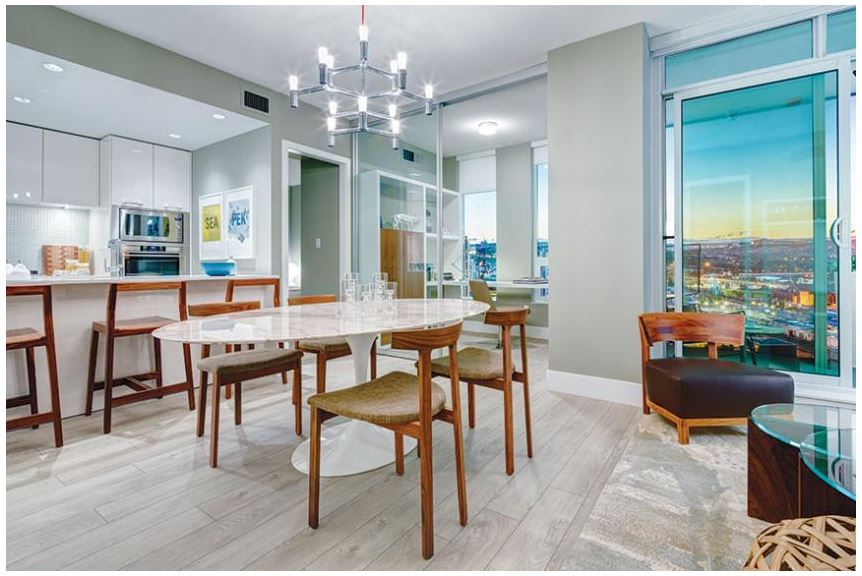Open Concept Ensures There’s Space to Entertain Graciously
Image of a MARK on 10th bright, open concept floorplan – Qualex-Landmark™
Whether it’s friends over for eggnog and a gift exchange or extended family for a turkey feast — December is a time when entertaining spaces are put to the test.
“You think about experiencing your home with others. We can’t help it,” says Cardel Lifestyles sales and marketing manager Brad Logel. His company’s current developments include Cranston Ridge, Auburn Walk, Nolan Park and Walden Place. “Even though it doesn’t happen as much as we all think it does — that’s the first thing you think about when looking at a place. You want to share it with the people you know and love.”
For apartment-style condos, there are a number of elements buyers can look for when deciding if the place they have their eye on will make hosting a success.
Topping the checklist? Keep dividing walls to a minimum.
“We have found that the open-concept floor plan design lends itself well to entertaining guests,” says Parham Mahboubi, Qualex-Landmark’s vice-president of planning and marketing. He says this orientation is more efficient for circulation and movement. Qualex-Landmark is behind Beltline condo towers Park Point, Mark on 10th, Calla and Luna.
“Unlike the traditional single-family house, where the kitchen, dining and living rooms are all broken up and separated by walls, we have found that the open-concept design in our condos promotes a more intimate interface is created between the kitchen area and the living or dining areas,” Mahboubi adds. “It creates opportunities for the host to maintain a more social environment in a shared space where the guests are in the host’s line of sight, so the host feels that they are not ignoring the guests while making preparations in the kitchen. More often, guests enjoy dialogue with their hosts while meal preparations are underway.”
When Tony Trutina of Truman Homes puts pen to paper on a new condo plan, “creating a functional space that is as open as possible is the main idea,” he says. His company’s developments includes Orchard Sky in SkyView Ranch, 1741 in Killarney/Shaganappi and Glenbrook Park.
When thinking about how his buyers will host, Trutina says the cooking space is a key ingredient.
“The kitchen is the hub of all households and is the main focal point in when creating a floor plan that is conducive to entertaining,” says Trutina. “This usually means, for us, ample counter top space and cabinets so the hub doesn’t get cluttered with countertop appliances, pots and pans.”
This clears up space for guests to bring their drinks and appetizers to the extended eating bar or island as the host puts the finishing touches on dinner.
“The good conversations are happening around the island,” says Brad Logel, adding large islands are part of many of Cardel Lifestyles’ floor plans. “It give you the ability to socialize while you work and your guests can also assist you on the other side. ‘Can I get you to open this bottle of wine? Would you mind mixing the salad for me? I’m going to check the turkey.’ ”
Mahboubi agrees, the ability to socialize within the kitchen is vital to any get-together, and reiterates the importance of keeping things open.
“When the meal is ready, it can be served right at the kitchen island or if there is separate dining room, guests and hosts still generally occupy the same shared space,” says Mahboubi. “Occupying this shared space throughout the evening whether socializing or dining, helps everyone feel connected and relaxed.”
But a fun conversation in the kitchen doesn’t mean much if people are shoulder-to-shoulder during dinner. A floor plan with generous space for the table is another thing to look for.
“If you can’t get four to six people to sit comfortably at the table then the design, to us, doesn’t function well,” Trutina says.
A table with a leaf extension can turn a table of six into seating for eight or 10. Having an open-concept orientation means there’s flexibility to temporarily make the dining space larger than it typically is.
“Depending on the number of guests you have, you need to be able to expand that dining room table,” Logel says. “Obviously open-concepts work well for this because your kitchen and dining area can expand and contract back to normal size for the next day when you don’t have that many people.”
Not to be forgotten is the great room. In some cases, this is where there’s a refill on that glass of merlot and a comfortable place for a gift exchange. Setting up a space where there isn’t the necessity for people to sit on the floor is something worth looking for.
“You have to have a living room that is large enough to have more than just one type of sitting furniture,” Logel says. “Maybe a love seat and two good chairs … depending on the number of guests you have.”
Open plans have a number of advantages, but spaces that feel individual can also be appealing.
“The kitchen area should flow nicely into the main family room where wine and cheese can be enjoyed without feeling like you’re still in the kitchen,” Trutina adds. “Accent lighting and the proper placement of the lighting in the family room helps frame and define, creating a better sense of a larger free-flowing space.”
Closets can sometimes be overlooked, but when entertaining, the simple luxury of a place for coats, hats, scarves and gloves make a difference.
“How many times have you been to other people’s place and ‘OK, you have to throw all the jackets in the bedroom on to the bed.’ Or we’re throwing them on the den’s desk table,’” says Logel. “So you need closet space, and if you have additional storage space, then you’re not having to worry about trying to transform something else.”
Author: Josh Skapin for Calgary Herald
Published: December 18, 2015
